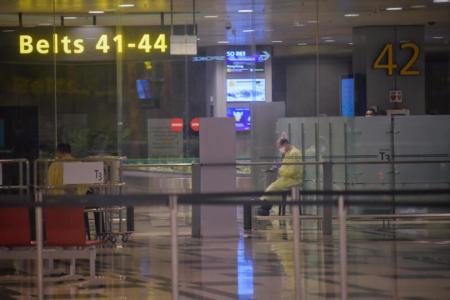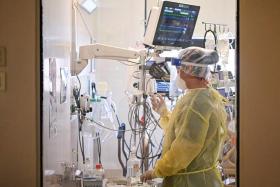Terminal 3 cluster began at arrival gates, baggage claim hall: CAG
The Changi Airport Terminal 3 (T3) cluster began at the arrival gates and baggage claim hall, where airport staff worked in close proximity to arriving passengers, investigations by Changi Airport Group (CAG) have shown.
About half of the airport workers who tested positive for Covid-19 were found spread out at the arrival zone, suggesting that areas where staff and arriving passengers were in close contact were the sites of the "primary infection", said CAG chief executive Lee Seow Hiang at a press conference yesterday.
Those working in these areas then mingled with others working in the transit areas, departure gates and the Basement 2 foodcourt - "where the risk profile is no different than the rest of Singapore" - leading to secondary clusters of infection that eventually spread the coronavirus to more than 100 people.
Mr Lee noted that the other zones were "relatively clean".
He said nearly 97 per cent of the 2,000 workers in the central transit area have been swabbed, with zero cases aside from a specific cluster of staff who were found to have mingled with those in the arrival zone.
A total of 43 positive Covid-19 cases have been detected among airport staff to date. Of these, about half - 10 at arrival gates and 11 at the baggage claim hall - worked at the arrival zone in T3.
The secondary cluster that Mr Lee referred to - at the transit area immediately bordering the arrival zone - has six cases.
Farther from this boundary, a lone case has been detected at the departure immigration checkpoint at the transit area.
SPREADING SITE
Another secondary spreading site is the Basement 2 foodcourt, where 12 of the 21 T3 arrival zone cases visited. Since then, 10 non-transit staff who visited the foodcourt have tested positive.
Last week, the Civil Aviation Authority of Singapore and CAG said the initial transmission that led to the T3 cluster could have occurred through an airport worker who was assisting a family from South Asia, who arrived here on April 29.
Asked by reporters how exactly this happened, Mr Lee said: "We have disclosed what we know from a CAG point of view, and I don't want to speculate on the other details that are ongoing in the investigations.
"We are taking a complete, comprehensive look, based on the World Health Organisation's and our own health authorities' understanding of the different modes of transmission.
"That is more or less the most important at the moment, over and above the micro-aspects of individuals."
Get The New Paper on your phone with the free TNP app. Download from the Apple App Store or Google Play Store now


